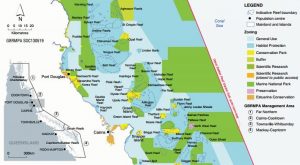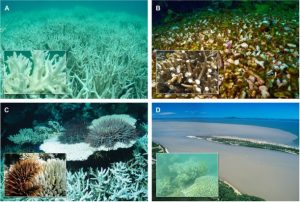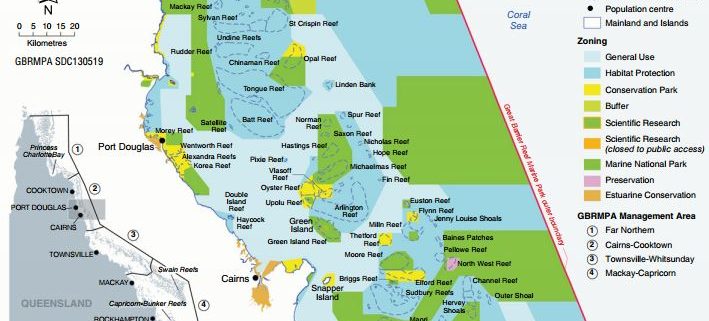Great Barrier Reef No-Take Areas Include a Range of Disturbance Regimes
By Shubham Mathur, SRC Intern

Figure 1: Zoning map for the Cairns area within the Great Barrier Reef Marine Park describing different zoning designations. The Inset map provides a reference to the location of the region in a broader scale.
The zoning of marine protected areas and reserves that prohibit or reduce human activity is a common example of spatial management used to protect natural assets for current and future benefit. Both the distribution and size of the protected areas are crucial factors in their effectiveness. Marine spatial planning (MSP) is crucial for developing effective protections, taking a number of factors into account including current and predicted future patterns of use, the habitat condition, how well represented the habitat already is in marine protected areas, and key ecological processes such as larval connectivity. The Great Barrier Reef Marine Park off the coast of Eastern Australia is considered to be a global icon of marine ecosystem management. The Marine Park was rezoned in 2004 in order to increase the reach and effectiveness of no take areas over the park. An expert focus group suggested that a minimum of 20% of the Marine Park should be protected by no take areas. This incorporated events such as cyclones, pollution, climate change, and other major disturbances into account. At the time, limited data did not allow re zoning to take into account variation in exposure of the reefs to disturbances. The Great Barrier Reef Marine Park should have management objectives should incorporate aspects of dynamic phenomena. For the purposes of this study, four coral mortality causing disturbances were studied in the context of special patterns of exposure. These disturbances are mass bleaching events, cyclones, crown of thorns starfish, and low salinity.

Figure 2: (A) Thermal stress related coral bleaching (B) Damage caused by cyclone waves (C) Damage caused by crown of thorns starfish outbreaks (D) Damage resulting from excessive freshwater inundation
The researchers gathered data on the four harmful disturbances found on the reef, collecting information regarding bleaching level thermal stress from 1982 to 2012, damaging waves from cyclones from 1985 to 2014, crown of thorns starfish outbreaks from 1982 to 2014, and freshwater inundation from 2001to 2011. The values for different levels of exposure for each disturbance were standardized, resulting in a scale from 0 to 1, where lower values indicate lower exposure, and higher values indicate higher exposure. Relative exposure was assessed by finding the mean scores of all four disturbances across the surveyed areas.
The relative exposure of the reef to bleaching resultant thermal stresses was relatively high for a little over 20 percent of the reef area, while a little over 30 percent of the reef area experienced a low exposure to thermal stresses. Similarly, approximately 20% of the reef experienced a high exposure to damaging waves from cyclones, and a little under 30% experienced low exposure. High exposure to the crown of thorns starfish was much more limited, at about 14% of the reef area, and 96% of the reef experienced no exposure to freshwater inundation. Only about 0.1% of the reef remained disturbance free for the duration of the surveys.
The analysis showed that even in no take areas, much of the reef suffered from one or more examples of harmful disturbances. This conclusion indicates that one of the most helpful things to do, would be to employ extra protections on the regions that did not experience any of the disturbances. Vulnerability for the different regions of the reef can be calculated by factoring exposure and sensitivity, along with the adaptive capacity of the area. A strong understanding of resilience and exposure allows for adaptive, resilience based management to maximize their benefits to the reefs, ensuring the future health and survival of the reef environments.
Maynard, J. A., Beeden, R., Puotinen, M., Johnson, J. E., Marshall, P., Hooidonk, R., … & Ban, N. (2015). Great Barrier Reef no‐take areas include a range of disturbance regimes. Conservation Letters.




Leave a Reply
Want to join the discussion?Feel free to contribute!